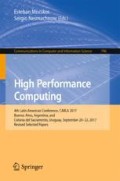Abstract
The Fog and Edge Computing paradigms have emerged as a solution to limitations of the Cloud Computing model to serve a huge amount of connected devices efficiently. These devices have unused computing power that could be exploited to execute parallel applications.
In this work we present SherlockFog, a tool to experiment with parallel applications in Fog and Edge network setups, specially focused on the MPI based applications. We propose a methodology to study feasibility of running parallel applications in Fog or Edge environments. We validate this tool contrasting experimental results with theoretical predictions reaching remarkable agreement between both.
We analyze the effect of worsening network conditions for several benchmarks of the MPI version of NAS Parallel Benchmarks on fog-like network topologies. Our results show that this impact is sublinear in some cases, opening up opportunities to use distributed, increasingly ubiquitous computational resources.
Access this chapter
Tax calculation will be finalised at checkout
Purchases are for personal use only
Notes
- 1.
- 2.
A/30 network prefix.
- 3.
- 4.
Each link’s weight is set to how much its delay is increased with respect to the underlying platform.
- 5.
In the no extra latency case, the topology remains unchanged, but the latency of every link is exactly the same.
References
Dimemas. http://tools.bsc.es/dimemas. Accessed 2 Dec 2017
ns-3 Direct Code Execution. https://www.nsnam.org/overview/projects/direct-code-execution/. Accessed 2 Dec 2017
ns-3 Overview. https://www.nsnam.org/docs/ns-3-overview.pdf. Accessed 2 Dec 2017
Bailey, D., Barszcz, E., Barton, J., Browning, D., Carter, R., Dagum, L., Fatoohi, R., Fineberg, S., Frederickson, P., Lasinski, T., Schreiber, R., Simon, H., Venkatakrishnan, V., Weeratunga, S.: The NAS parallel benchmarks. Report RNR-94-007, Department of Mathematics and Computer Science, Emory University, March 1994
Barabási, A.L., Albert, R.: Emergence of scaling in random networks. Science 286, 509–512 (1999)
Bonomi, F., Milito, R., Zhu, J., Addepalli, S.: Fog computing and its role in the internet of things. In: Proceedings of the First Edition of the MCC Workshop on Mobile Cloud Computing, MCC 2012, pp. 13–16. ACM, New York (2012). http://doi.acm.org/10.1145/2342509.2342513
Brandfass, B., Alrutz, T., Gerhold, T.: Rank reordering for MPI communication optimization. Comput. Fluids 80, 372–380 (2013). Selected Contributions of the 23rd International Conference on Parallel Fluid Dynamics ParCFD2011. http://www.sciencedirect.com/science/article/pii/S004579301200028X
Casanova, H., Giersch, A., Legrand, A., Quinson, M., Suter, F.: Versatile, scalable, and accurate simulation of distributed applications and platforms. J. Parallel Distrib. Comput. 74(10), 2899–2917 (2014). http://hal.inria.fr/hal-01017319
Degomme, A., Legrand, A., Markomanolis, G., Quinson, M., Stillwell, M., Suter, F.: Simulating MPI applications: the SMPI approach. IEEE Trans. Parallel Distrib. Syst. PP(99), 1 (2017)
Dichev, K., Rychkov, V., Lastovetsky, A.: Two algorithms of irregular Scatter/Gather operations for heterogeneous platforms. In: Keller, R., Gabriel, E., Resch, M., Dongarra, J. (eds.) EuroMPI 2010. LNCS, vol. 6305, pp. 289–293. Springer, Heidelberg (2010). https://doi.org/10.1007/978-3-642-15646-5_31
Gropp, W., Lusk, E., Skjellum, A.: Using MPI: Portable Parallel Programming with the Message-Passing Interface, 2nd edn. MIT Press, Cambridge (1999)
Gropp, W., Lusk, E., Thakur, R.: Using MPI-2: Advanced Features of the Message-Passing Interface, 2nd edn. MIT Press, Cambridge (1999)
Hemminger, S.: Network emulation with NetEm. In: Pool, M. (ed.) LCA 2005, Australia’s 6th National Linux Conference (linux.conf.au). Linux Australia, Sydney (2005). http://developer.osdl.org/shemminger/netem/LCA2005_paper.pdf
Lantz, B., Heller, B., McKeown, N.: A network in a laptop: rapid prototyping for software-defined networks. In: Proceedings of the 9th ACM SIGCOMM Workshop on Hot Topics in Networks, Hotnets-IX, pp. 19:1–19:6. ACM, New York (2010). http://doi.acm.org/10.1145/1868447.1868466
Mercier, G., Clet-Ortega, J.: Towards an efficient process placement policy for MPI applications in multicore environments. In: Ropo, M., Westerholm, J., Dongarra, J. (eds.) EuroPVM/MPI 2009. LNCS, vol. 5759, pp. 104–115. Springer, Heidelberg (2009). https://doi.org/10.1007/978-3-642-03770-2_17
Navaridas, J., Pascual, J.A., Miguel-Alonso, J.: Effects of job and task placement on parallel scientific applications performance. In: 2009 17th Euromicro International Conference on Parallel, Distributed and Network-Based Processing, pp. 55–61, February 2009
Shi, W., Cao, J., Zhang, Q., Li, Y., Xu, L.: Edge computing: vision and challenges. IEEE Int. Things J. 3(5), 637–646 (2016)
Wette, P., Dräxler, M., Schwabe, A.: Maxinet: distributed emulation of software-defined networks. In: 2014 Networking Conference, IFIP, pp. 1–9, June 2014
White, B., Lepreau, J., Stoller, L., Ricci, R., Guruprasad, S., Newbold, M., Hibler, M., Barb, C., Joglekar, A.: An integrated experimental environment for distributed systems and networks. In: Proceedings of the Fifth Symposium on Operating Systems Design and Implementation, pp. 255–270. USENIX Association, Boston, December 2002
Acknowledgements
The authors would like to thank D. González Márquez for his assistance with schematic drawings and the Centro de Simulación Computacional para Aplicaciones Científicas/CSC-CONICET and the Centro de Cómputos de Alto Rendimiento (CeCAR, FCEN-UBA) for providing the equipment we haved used in the experimental setup.
Author information
Authors and Affiliations
Corresponding author
Editor information
Editors and Affiliations
Rights and permissions
Copyright information
© 2018 Springer International Publishing AG
About this paper
Cite this paper
Geier, M., Mocskos, E. (2018). SherlockFog: Finding Opportunities for MPI Applications in Fog and Edge Computing. In: Mocskos, E., Nesmachnow, S. (eds) High Performance Computing. CARLA 2017. Communications in Computer and Information Science, vol 796. Springer, Cham. https://doi.org/10.1007/978-3-319-73353-1_13
Download citation
DOI: https://doi.org/10.1007/978-3-319-73353-1_13
Published:
Publisher Name: Springer, Cham
Print ISBN: 978-3-319-73352-4
Online ISBN: 978-3-319-73353-1
eBook Packages: Computer ScienceComputer Science (R0)

